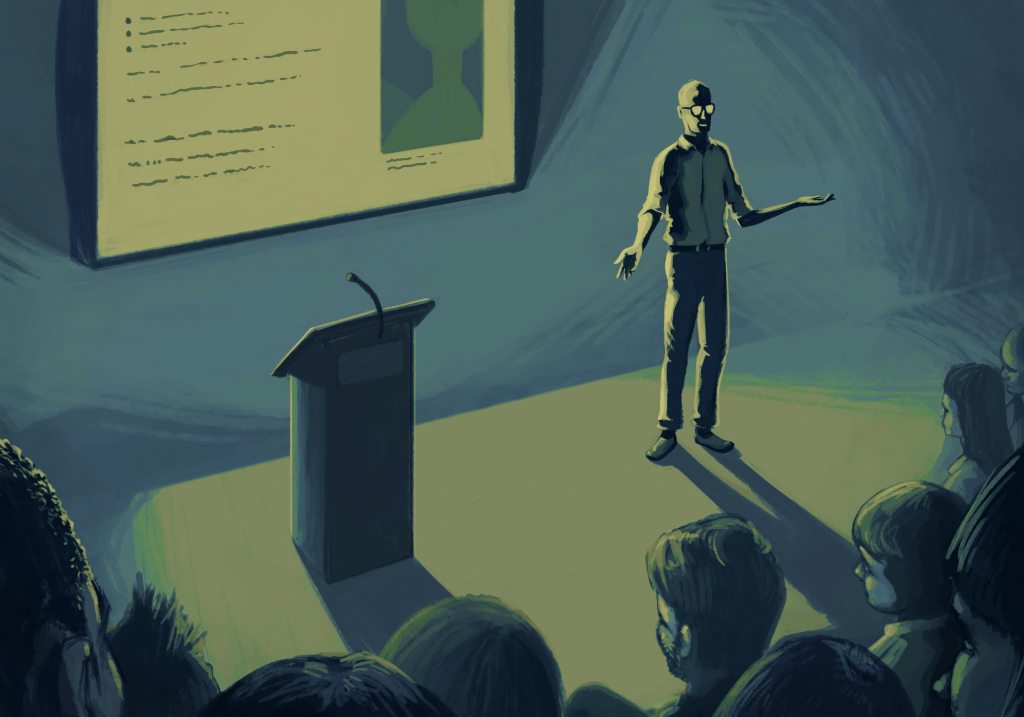Helpful Hints: Effectively Communicate & Present
Whether pitching an idea or presenting yourself during dailies, knowing how to speak to others is an important part of all digital media industries. Without effective communication, ideas are lost, people lose interest and stop caring. Here are some things to keep in mind when communicating with a group.
Your Voice
Project your voice. Make sure that everyone can hear what you’re saying. If you are talking to a larger group, you must speak louder than normal. If they cannot hear you, they are not listening.
Speak clearly. There are several things to remember to ensure that the audience understands what you are saying. Keep in mind your pacing, if you rush through what you have to say, people will not be able to catch everything. Also be sure to enunciate your words. If you are struggling with any of the vocabulary, practice saying it beforehand. If you are still unable to pronounce the word correctly after practice, change the vocabulary.
Pitch & Tone. When you project your voice, you may find that it becomes extremely high and squeaky. Try to control how high pitched you are, being too squeaky can be a turn off for audiences. Also try to vary your tone. A monotone voice loses interest from listeners. Do not be afraid to sound passionate or excited.
Fillers. These are words such as “like”, “um”, “yeah”, “and then” and “ya’ know”. They detract from what you have to say. Whenever you feel yourself about to use a filler word, pause instead of saying it. Your listeners will not notice your pause, and your mind will have a chance to catch up with your mouth.
Having an Outline
If you are presenting an idea or giving a speech, it is very important to prepare an outline beforehand. The outline will help you master the information you would like to present, and can be used as an aid during your presentation. If you are presenting work to a group of people for critique or progress check, you do not need a fully developed outline. Instead just keep in mind what you would like to say about your work, as well as any questions you may have for feedback.
What Makes an Outline. It is important to remember that an outline is not a fully fledged, word by word, copy of your speech. An outline is bullet pointed information that reminds you what you want to say. It is structured very similarly to an essay, having an introduction (introduce yourself, attention grabber, thesis statement, reasons/topics), transitions between each new topic, your topics (main argument with explanations and examples) and a conclusion (repeat thesis, touch on main points, closing statement, thank you for your time). Do not worry if you change your word choice or phrasing either, outlines are not contracts you must abide by. Keep speaking if you change something, nobody will know it happened expect you
Do Not Read Directly from a Paper. Eye contact is very important when speaking to a group, and you cannot do it if you are staring at your paper. Look out at the audience, establish a connection and ensure they are listening. If you choose to have your outline with you while presenting, do not rely on it. It should only be glanced at quickly while speaking in case you are having trouble remembering what you want to say. Remember to not read it word for word. Freeing yourself from this pressure will allow you to speak naturally.

Embrace Your Space
While speaking, you do not have to stand perfectly still. If you move around, you will become more engaging to your listeners.
Do Not Hide. If you are presenting something to your class, do not hide behind the computer. Stand up and talk to them, be just as engaged with them as you want them to be with you. If you are presenting and there is a podium, do not feel as though you have to utilize it the entire time. You can start with it, then use the space around you, and when you are ready to conclude be back at the podium.
Move with Purpose. While moving around your space can be beneficial, it is important to keep in mind not to wander aimlessly. If you would like to move, it is recommended to do it on a transition in your speech. This prevents the movement from distracting your listeners from what you have to say. Fast and exaggerated movements should also be avoided. They are distracting and will cause the audience to focus on your actions instead of what you are saying.
Move Forward. If you really want to gain your listener’s attention, take a step forward when you introduce yourself and if you are asking them a question.
Audio & Visual Aids
Being artists, audio and visual aids are going to be used almost every time we are presenting our work or ideas. It is important to get comfortable with being prepared with and utilizing them now.
Technical Difficulties. Be prepared for things to not work out. Come prepared with extra files, and your work saved in different formats so that it can be viewed on all computers. The biggest thing to keep in mind is to not let any problems ruin your presentation or speech. Be prepared to have to explain your ideas without aids. If you are using sound, make sure you check the volume beforehand.
Do Not Block Them. It is important to know where your visuals are going to be so that you do not block them. If your viewers cannot see your visuals, then there is no point in having them.
Have a Purpose. Make sure the aids you choose have a purpose. They should connect with and strengthen your topic. Random visuals and audio will distract the audience.
Hand-Outs. If you have materials to hand out, print more than you need. Keep one for yourself, and extras in case there are more people than expected or some copies get damaged.
Other Things to Keep in Mind
Here are a few other things to keep in mind.
Posture. Have good posture when you are in the listener’s view. Good posture displays confidence, causing your audience to listen to what you have to say. It is also important to face the audience at all times, even if you decide to move around the space.
Time. If you have a limited amount of time to speak, make sure you time yourself when you practice.
Know Your Audience. This will determine how you present your information, your vocabulary and attire.
Nerves. It is normal to feel nervous or anxious. The right amount of adrenaline will help you, however if you are too anxious you may forget what you wanted to say, trail off topic or speak too fast. To prevent this, try to do some physical activity the day of, if you exercise everyday then increase the intensity. If you drink caffeine, consume less or none on the day you are speaking. Do not drink any alcoholic beverages or “self medicate” beforehand, this will only detract from the speech you give and tarnish your reputation.
Clothing. Certain clothing can be distracting for you and your listeners. Avoid thing that are very reflective, or outlandish for where and who you will be speaking to. If you play with your clothing when nervous, avoid wearing items that you constantly adjust. These could be long sleeves, a dress, jewelry, belts, ties, etc. If you tend to play with your hair, it would be beneficial for you to put your hair up and out of the way.
Mistakes. If you make a mistake, do not stop, do not apologize, just keep going. Most of the time nobody will notice any mistakes that you make. Even if they do, acknowledging what happened disrupts your own train of thought and allows the audience to become more focused on your mistake instead of your idea. If you need to collect yourself, pause for a second or two and then move on.
Being able to effectively communicate and present your ideas and work is a major part of being successful in digital media industries. It is important to practice this now, learn the tools and techniques that work for you and implement them in the future.
Illustration by Jackson Ellis. See more of his work at instagram.com/jellistrations
